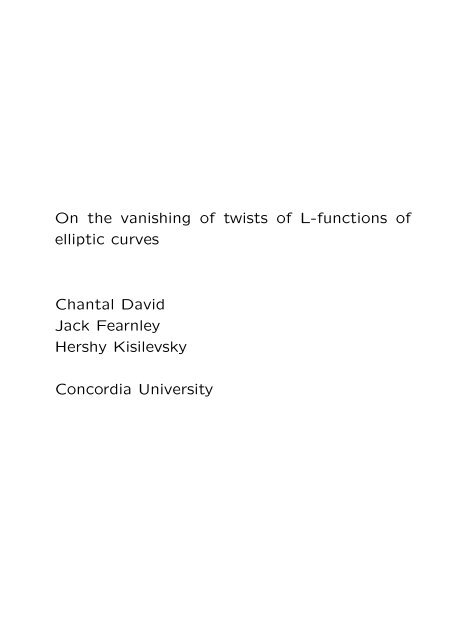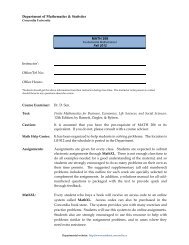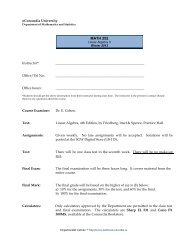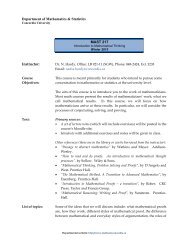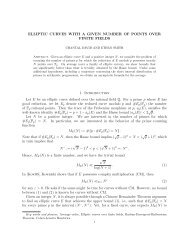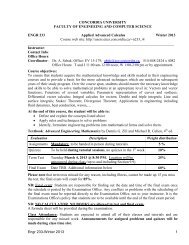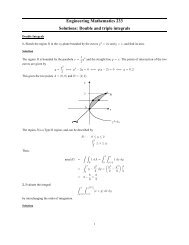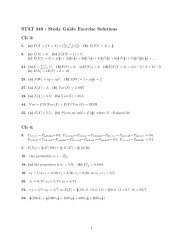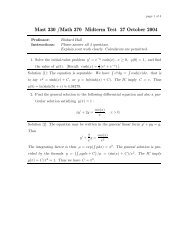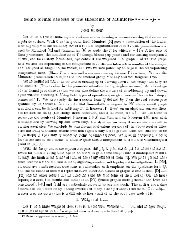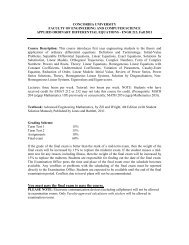On the vanishing of twists of L-functions of elliptic curves Chantal ...
On the vanishing of twists of L-functions of elliptic curves Chantal ...
On the vanishing of twists of L-functions of elliptic curves Chantal ...
You also want an ePaper? Increase the reach of your titles
YUMPU automatically turns print PDFs into web optimized ePapers that Google loves.
<strong>On</strong> <strong>the</strong> <strong>vanishing</strong> <strong>of</strong> <strong>twists</strong> <strong>of</strong> L-<strong>functions</strong> <strong>of</strong><strong>elliptic</strong> <strong>curves</strong><strong>Chantal</strong> DavidJack FearnleyHershy KisilevskyConcordia University
Twisted L-seriesLet E/Q be an <strong>elliptic</strong> curve with conductorN E and L-functionL E (s) =∞∑n=1a nn s.Functional Equation:(√ ) s NEΛ E (s) = Γ(s)L E (s) = w E Λ E (2 − s)2πThen, w E = −1 ⇒ L E (1) = 0.Let χ be a character <strong>of</strong> conductor f and letL E (s, χ) =Functional Equation:∞∑n=1a n χ(n)n s .Λ E (s, χ) =( √ ) s f NEΓ(s)L E (s, χ)2π= w E χ(N E ) τ(χ) 2Λ E (2 − s, χ).fwhere τ(χ) is <strong>the</strong> Gauss sum.1
Quadratic charactersLet χ d be a quadratic character <strong>of</strong> discriminantd. Then,χ d = χ d and L E (s, χ d ) = L Ed (s).The sign <strong>of</strong> <strong>the</strong> functional equation isw E χ d (−N E ) = ±1and L Ed (1) which vanishes for about half <strong>the</strong>discriminants d.Conjecture (Birch and Swinnerton-Dyer)rank(E) = ord s=1 L E (s)We writeN ∗ (X) = # {|d| ≤ X : rank(E d ) is *}Conjecture (Goldfeld)N 0 (X) ∼ N 1 (X) ∼ 6 π 2 XN ≥2 (X) = o(X)In o<strong>the</strong>r words, <strong>the</strong> average rank is as small asit can be.2
Lower bounds and asymptotic for N ∗ (X)N ≥2 (X) ≫ X 1/2 (Gouvêa-Mazur)under <strong>the</strong> parity conjectureN ≥2 (X) ≫ X 1/7 log −2 (X) (Stewart-Top)N ≥2 (X) ≫ X 1/3 (Rubin-Silverberg)when E has rational 2-torsionN ≥3 (X) ≫ X 1/6 (Rubin-Silverberg)for some special EConjecture (Conrey, Keating, Rubinstein andSnaith) There are constants b E ≠ 0 and e Esuch thatwhen X → ∞.N ≥2,even (X) ∼ b E X 3/4 log e E X3
Higher order <strong>twists</strong>Let k be an integer greater than 2, and considercharacters <strong>of</strong> order k.Questions:Infinitely many χ with L E (1, χ) = 0 ?Positive proportion <strong>of</strong> χ with L E (1, χ) = 0 ?Precise asymptotic ?Empirical <strong>vanishing</strong> for cubic <strong>twists</strong>Curve Maximal Number <strong>of</strong> Number <strong>of</strong>(Torsion) conductor characters <strong>vanishing</strong>E11A (5) 2,023,513 320,795 1152E14A (6) 2,108,767 260,001 4347E15A (8) 399,979 51,890 807E32A (4) 300,217 47,577 117E36A (6) 283,051 36,718 346E37A (1) 279,211 41,991 559E37B (3) 364,723 54,830 1899E389A (1) 99,991 15,851 4084
Cubic <strong>twists</strong>Let K/Q be a cyclic cubic field with charactergroup Ĝ = {1, χ, χ}. ThenL(E/K, s) = L E (s) L E (s, χ) L E (s, χ)and <strong>the</strong> <strong>vanishing</strong> <strong>of</strong> L E (s, χ) is related to <strong>the</strong>rank <strong>of</strong> E over K.Theorem (Fearnley-Kisilevsky) If E has rational3-torsion, <strong>the</strong>n# {K with f K ≤ X : rank E(K) > rank E(Q)}≫ X 1/2 .We denoteN(X) = {χ cubic with f χ ≤ X} ∼ c 3 XN E (X) = {χ ∈ N(X) with L E (s, χ) = 0} .Question:<strong>of</strong> N E (X)?What is <strong>the</strong> asymptotic behavior5
Random matricesPhilosophy for a family F <strong>of</strong> L-series with symmetrytype G(N):- Katz and Sarnak: statistics on <strong>the</strong> lowlyingzeroes <strong>of</strong> L f (s) in F should fit those<strong>of</strong> <strong>the</strong> eigenvalues <strong>of</strong> random matrices inG(N);- Keating and Snaith: statistics on <strong>the</strong> values<strong>of</strong> L f (s) in F should fit those <strong>of</strong> <strong>the</strong>characteristic polynomials <strong>of</strong> random matricesin G(N).Experimental and <strong>the</strong>oritical evidence:Montgomery, Odlyzko, Katz-Sarnak, Rudnick-Sarnak, Conrey-Ghost, Conrey-Farmer ...6
Families <strong>of</strong> L-<strong>functions</strong> and symmetry types• Unitary G(N) = U(N) :{ζ(1/2 + it), t ≥ 0}• Symplectic G(N) = Sp(2N) :{L(1/2, χ d ), χ d quadratic character}• Orthogonal G(N) = SO(2N) :{L(1/2, f), f ∈ S k (Γ 0 (N)) with k fixed}For <strong>the</strong> family <strong>of</strong> cubic <strong>twists</strong>, we have unitarysymmetries as- <strong>the</strong> signs <strong>of</strong> <strong>the</strong> functional equation areuniformly distributed on <strong>the</strong> unit circle (Heath-Brown and Patterson);- behavior <strong>of</strong> <strong>the</strong> moments <strong>of</strong> |L E (1, χ)|.7
MomentsLet k be a positive integer.2kth momentsM E (2k, X) = 1N(X)∑f χ ≤XWe consider <strong>the</strong>|L E (1, χ)| 2kwhere ∑ f χ ≤X runs over all cubic characters <strong>of</strong>conductor f χ ≤ X.Conjecture (Keating and Snaith)M E (2k, X) ∼ a E (k) g k (2 log X) k2as X → ∞whereg k =k−1 ∏j=0j!(j + k)!and a E (k) is an arithmetical factor related to<strong>the</strong> curve E.8
Empirical Moments1 2 3 4E11A E 2.878 22.02 274.3 4617.C 2.962 22.34 227.7 2288.E/C 0.972 0.985 1.205 2.017E14A E 2.196 11.76 104.6 1302.C 2.243 11.66 83.18 599.8E/C 0.979 1.008 1.257 2.171E15A E 2.609 15.86 149.4 1874.C 2.677 15.87 117.9 816.9E/C 0.974 1.000 1.266 2.294E32A E 1.928 7.863 49.23 407.2C 1.946 7.468 35.42 154.8E/C 0.991 1.052 1.389 2.630E36A E 1.792 6.491 35.34 253.6C 1.814 6.101 24.29 86.90E/C 0.988 1.063 1.454 2.919E37A E 3.196 29.50 441.3 8592.C 3.280 29.40 341.3 3547.E/C 0.974 1.003 1.292 2.421E37B E 1.656 6.060 36.15 311.3C 1.646 5.395 22.69 93.66E/C 1.006 1.123 1.593 3.32310
Random matricesKeating and Snaith: statistics on <strong>the</strong> values <strong>of</strong>L f (s) in F should fit those <strong>of</strong> <strong>the</strong> characteristicpolynomials <strong>of</strong> random matrices in G(N).For each A ∈ G(N), letλ 1 = e iθ 1, . . . , λ N = e iθ Nbe <strong>the</strong> eigenvalues <strong>of</strong> A ordered such that0 ≤ θ 1 ≤ . . . ≤ θ N < 2πand letP A (λ) = det (A − λI)be <strong>the</strong> characteristic polynomial <strong>of</strong> A.Notice thatP A (1) = 0 ⇐⇒ λ 1 = e iθ 1 = 1 ⇐⇒ θ 1 = 011
The unitary groupJ. P. Keating, N. C. Snaith, Random matrix<strong>the</strong>ory and ζ(1/2 + it).Moments for |P A (1)| in U(N):M U (s, N) ==∫U(N) |P A(1)| s dHaarN∏j=1Γ(j)Γ(j + s)Γ 2 (j + s/2)is analytic for Re(s) > −1 with meromorphiccontinuation to <strong>the</strong> whole complex plane.Distribution function:P U (x, N) = 12πifor some c > −1.∫(c) M U(s, N)x −s−1 ds.For x smallP U (x, N) ∼ 1Γ(N)N∏j=1Γ(j) 2Γ 2 (j − 1/2) = R(N).12
When N → ∞R(N) → N 1/4 G 2 (1/2)where G is <strong>the</strong> Barnes G-function.Moments <strong>of</strong> L E (1, χ):M E (s, X) = 1N(X)∑f χ ≤X|L E (1, χ)| s .From <strong>the</strong> correspondance <strong>of</strong> Keating and Snaithwe conjecture that|L E (1, χ)| ↔ |P A (1)|,M E (s, X) = a E (s)M U (s, N)for <strong>the</strong> arithmetical factor a E (s) andN ∼ 2 log X(equating <strong>the</strong> densities <strong>of</strong> zeroes at a fixedheight).Probability distribution for small x:∫P E (X, x) = 12πiM E(s, X)x −s−1 ds(c)∼ a E (−1)R(N)13
Discretisation <strong>of</strong> L E (1, χ)Following Mazur-Tate-Teitelbaum,L algE (1, χ) = 2 f χ L E (1, χ)Ω τ(χ)= ∑χ(a)Λ(a, f χ )a mod fwhere Λ(a, f χ ) ∈ Z and Ω is a certain non-zerorational multiple <strong>of</strong> <strong>the</strong> real period Ω E . Clearly,L algE(1, χ) ∈ Z[ρ].Lemma|L algE (1, χ)| = ⎧⎪⎨⎪ ⎩n χ if w E = 1;√3 nχ if w E = −1;for some positive integer n χ .Then,|L E (1, χ)| = c En χ√fχ.14
Distribution <strong>of</strong> <strong>the</strong> integers n χCurve E11A E14A E15A E37BFactor 10 6 8 12Torsion 5 6 8 3n χ = 0 1152 4347 807 1899n χ = 1 1662 344 287 150n χ = 2 1117 440 229 136n χ = 3 2676 1379 414 1419n χ = 4 1328 336 660 171n χ = 5 1069 288 219 147n χ = 6 1711 2707 470 785n χ = 7 1827 390 327 188n χ = 8 1125 442 504 105n χ = 9 2578 2365 378 2853n χ = 10 631 293 174 88n χ = 11 1336 299 227 118n χ = 12 2183 2188 872 993n χ = 13 1607 365 274 149n χ = 14 1015 489 229 98n χ = 15 1625 1044 288 810Proposition Suppose that E is isogenous to acurve with rational 3-torsion. Then3 ν(f χ)−1 | n χ .15
LetB(f χ ) =⎧⎪⎨⎪⎩c E 3 ν(f χ)−1√fχif E(Q)[3] ≠ ∅;c E√fχo<strong>the</strong>rwise.Then, Prob (|L E (1, χ)| = 0) is= Prob (|L E (1, χ)| < B(f χ ))=∫ B(fχ )0a E (−1/2) R(N) dx= a E (−1/2) R(N) B(f χ ).Summing <strong>the</strong> probabilitiesN E (X)∼⎧⎪⎨⎪⎩b E X 1/2 log 1/4 X E(Q)[3] = ∅;b E X 1/2 log 9/4 X E(Q)[3] ≠ ∅;16
Empirical results for E11A and E14A17


